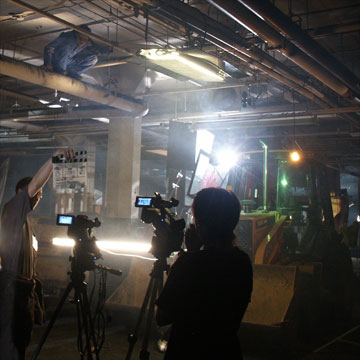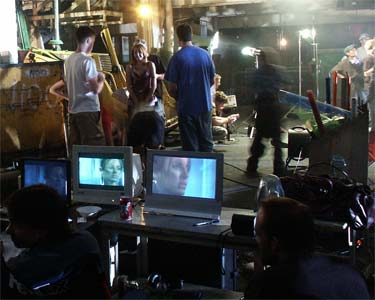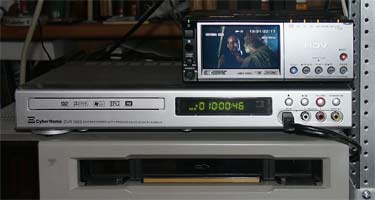| Trygve.Com > Diary > High Definition | Translate this page:
|
Mostly Films, LLC's production of The Shadow Walkers was my first experience being in a feature film shot in high-definition. It was a new experience, using cameras that had only been available for a few months at the time, but everything worked well with no major problems we were unable to overcome. |
|
These Sony cameras are not without their limitations, but they're still a tremendous value for the price. A minor issue, but one worth noting is that they actually record 1440 pixels across rather than 1920, so the native resolution is a little bit less than the 1080i format's full glory. Their native recording format is inherently interlaced (all the odd lines get recorded in one pass, followed by all the even lines, then the odd ones again, and so forth) instead of progressive (all the lines in a video frame are recorded in order in one pass), and though the camera will record and output progressive formats, these are generated internally in the camera by a hardware-based "bob-and-weave" deinterlacing scheme, starting with the interlaced output of the CCD.
|
The first movie in which I eat the rest of the cast |
Another limitation is the data format used to store the video. The HVR-Z1u records video to tape in the HDV-2 format, which is a 25 megabit-per-second MPEG2 data stream. That's the same format (just at a higher resolution) as is used on DVDs and like DVDs, most frames are interpolated from other frames rather than being stored in their entirety (as is the case on standard-definition DV). 25Mbps is a a moderate level of compression. A typical high-quality DVD might have its video stream compressed to 6Mbps, so in HDV-2, we're storing 4.5 times as many pixels (remember that the Sony's are using a horizontal resolution of 1440 pixels rather than 1920) at slightly more than four times the data rate. You can expect that any degradation in video quality due to the compression format is going to be no worse than it is on a good DVD.
|
On the plus side, the HDV format uses 4:2:0 color subsampling. That's a fancy way of describing how the camera saves details in the way the color of the picture changes compared to the degree of detail that it uses to record changes in brightness. Your eyes are more sensitive to changes in brightness than in color, so subsampling makes sense. Standard-definition NTSC DV uses 4:1:1 subsampling, which has the same amount of color information, but it distributes it differently. DVDs, however, use 4:2:0 subsampling, like HDV, so if you're not careful and sophisticated when converting from NTSC DV to DVD, you're going to end up with half the color detail that the DVD format could potentially hold. Starting from HDV, you don't have that problem. |
 we used two sony HVR-Z1u high-definition camcorders on The Shadow Walkers |
One other big limitation that I did see as potentially a major problem was the HDV sound format. It's not 48KHz 16-bit PCM like it is in standard DV; HDV audio is stored as a 384Kbps MPEG 1 Audio layer II stream. Pretty high-bandwidth as the MP2 format goes, so if you listen to it straight off the deck, it'll probably sound just fine to your ears. My concern, however, is that the MP2 format uses perceptual encoding and data reduction: the encoder looks at the frequencies making up the audio signal, decides that certain frequencies won't be audible because of other frequencies that are louder...and discards the ones it thinks you won't miss.
Trouble is, when you get to editing the sound on your movie, you're going to want to clean up your audio. You might need to filter out some hisses and hums, cut down on some residual street noise, etc. It's quite possible that the MP2 encoder will have thrown away some of the sounds you *do* want because it thought they'd be masked by the sounds you don't.
Hard to say how much of a problem that would present in actual practice, but mid-way through audio post is not the time you want to find out. Fortunately, it's easy to fix: we used a TASCAM DA-P1 portable DAT unit for the location sound, and we ran a tap off that to the balanced inputs on the cameras just for convenience.
|
As the start of production drew nearer, the cameras came in, but the problem of monitoring them remained unsolved. Nice as the LCD screens mounted on the cameras are, they don't really do the video justice and clustering the director, the continuity supervisor, and everybody else around a little camcorder display simply wouldn't be practical. The production company had elected to shoot the film in 25fps 1080p, and the HVR-Z1u converts that to 1080i 50ifps when outputting high-definition component video. I ran into director of photography Jeff Pointer two days before the first day of shooting and he'd been going to several electronics stores, trying to find a high-definition TV that would recognize that video format. So far, no luck. |
 We used laptops as well as high-definition TVs as video monitors |
I obtained a pair of Acer Aspire 3002LCi notebook computers with the idea of using them as high-definition video monitors. This particular model doesn't include a firewire input, so I installed firewire cards in them. For software, I installed VideoLAN's VLC Media Player which was able to capture and display the high-definition video sent in HDV format from the camera as it recorded.
Initially, the video quality was poor: it often moved jerkily and was plagued by missing pixels and groups of pixels. It looked like trying to play back a bad DV tape. Jon Firestone, second unit DP, discovered that going in to the video properties and turning off "write combining" fixed the video problems and then they worked like a charm. You could watch the video in high resolution and you could capture video or individual frames, something you can't do on a high-definition TV set. The one issue that remained unsolved was that this system did lag slightly behind real-time: the video flowed smoothly enough, but it was delayed by a second or a little less from what the camera was actually recording. I don't know whether the delay happens in the camera's encoding process or VLC Player's decoding process, however, and I haven't had the time or opportunity to test it.
Jeff Pointer did manage to find a display that would work off the 1080i/50fps component outputs off the camcorder: the Sony MFM-HT75W 17" LCD display. It's got a screen resolution of 1280x768, which is a bit less than the 1920x1080 resolution of 1080i HD, but it looked good enough and didn't suffer from the brief video delay that the laptops had. Of course, it wouldn't capture video (or replay it), so it was good to have both options.
The other downside of using a video monitor attached to the component outputs is that it avoids the delay inherent in converting to HDV by outputting the raw video before it gets compressed and converted. That's great if you want the option of using an outboard component high-def-to-SDI converter or capture card to avoid the compression artifacts, reduction in color depth and detail, and quality loss in images with rapid movement of subjects or camera inherent in squeezing everything down to a 25mbps MPEG-2 4:2:0 subsampled data stream. That's not quite so great if you want to monitor what's actually being recorded on the tape, because what you're monitoring is the unprocessed video image, not the compressed image that's being saved.
The firewire output we ran to the laptops, however, is by necessity the subsampled, compressed, and encoded version, so it should match what's being saved to tape exactly. By having both the laptops and the video monitor hooked up, we able to compare the pre- and post-processed versions of the video as it was recorded.

A Sony HVR-M10u HDV deck was used to convert the high-definition video into 50i standard-definition video and output it in DV format over firewire. This went into a Cyberhome DVR-1600 DVD recorder which had no problem writing this not-quite-standard video format to a DVD that worked in all the players we tried. |
The next issue was that of converting everything shot on a given day to a format the director and others could view on the video equipment they had. Sony's HVR-M10u HDV deck will downconvert high-definition video to standard definition and output that through its video outputs (composite, S-video, and component) or in DV format through its firewire port. What the deck doesn't do, however, is change the frame rate, so even though the resolution was that of standard-definition NTSC, it was being generated at 50 frames per second rather than the 59.94 frames-per-second rate that is standard for NTSC. I'd been worried that the 50 frames-per-second rate would cause the same problems with DVD recorders that it did with almost all of the high-definition TVs, but the Cyberhome DVR-1600 DVD recorder had no problems accepting this format and writing it to DVD. |
Capturing the high-definition video for editing purposes ended up being a little more complex. I had used CapDVHS to capture the HDV video to M2T format, but Premiere 1.51 (which, supposedly, supports this format) would hang when reading the M2T files, whether they were renamed to MPG or otherwise. Other applications had no trouble, but the only editing tools I have out here are Premiere and Avid Xpress DV (which doesn't support HDV--but I've since gotten the Avid HD upgrade).
The MainConcept MPEG Pro plugin for Premiere allows Premiere to edit the M2T files generated by CapDVHS just fine, but it's $349 and the demo version watermarks your video, and I wasn't ready to pay $349 for the plugin without doing more research first.
Cineform makes the codec for Premiere 1.51 that was supposed to allow it to read HDV files. Interestingly, The standalone version, Cineform Aspect HD reads the files just fine and can convert them to the high-definition Cineform codec with no problems. That'll set you back $499, but you can try out a fully-functional demo version for 15 days, with no watermarking or other limitations. That's what I did, and now I'm working on editing the raw footage in Premiere with no problems.
There's probably a better way to have done this. Capturing directly in Premiere would have made more sense, but that wasn't working for me for some reason and I haven't had the time to figure out why. The above process may not be ideal, but it did work.
I then needed to produce edited files that could be read by Final Cut Pro on the Apple Macintosh platform. Final Cut Pro doesn't support the Cineform codec, so I exported the edited segments in m2t format. The codec to do this doesn't come with Premiere 1.51, but installing the trial version of Cineform Aspect HD also installs the necessary codec, and I had no problems continuing to use that option even after the trial period had expired.
This step was quite time-consuming: taking about 4 hours per hour of video on both my 2.66GHz dual Xeon system and the Athlon 64 3400 system I had on hand. (The dual-Xeon system was a little bit faster at this task than the single Athlon 64). If I'd done my edits with MainConcept MPEG Pro instead of using the Cineform codec, this step could have been avoided.
However, Final Cut Pro won't read the multiplexed Mpeg-2 format used in the m2t files, but an Italian company called Squared 5 makes a fast and easy utility, MPEG Streamclip that demuxes the Mpeg-2 stream into a format Final Cut Pro will read. The Mpeg2/AIFF demuxing option is what worked for me. That step, at least, does not involve transcoding or otherwise recompressing the video, so it's fast and won't affect video quality in any way.
|
The next step will be digitizing and synching the better-quality location audio of the DAT tapes. To save time, I'll be digitizing them with one of my audio-capable SCSI DAT drives which can rip the audio off the tapes at better than twice normal speed. |
|